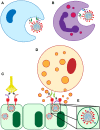Extra-Neutralizing FcR-Mediated Antibody Functions for a Universal Influenza Vaccine
- PMID: 30949165
- PMCID: PMC6436086
- DOI: 10.3389/fimmu.2019.00440
Extra-Neutralizing FcR-Mediated Antibody Functions for a Universal Influenza Vaccine
Abstract
While neutralizing antibody titers measured by hemagglutination inhibition have been proposed as a correlate of protection following influenza vaccination, neutralization alone is a modest predictor of protection against seasonal influenza. Instead, emerging data point to a critical role for additional extra-neutralizing functions of antibodies in protection from infection. Specifically, beyond binding and neutralization, antibodies mediate a variety of additional immune functions via their ability to recruit and deploy innate immune effector function. Along these lines, antibody-dependent cellular cytotoxicity, antibody-mediated macrophage phagocytosis and activation, antibody-driven neutrophil activation, antibody-dependent complement deposition, and non-classical Fc-receptor antibody trafficking have all been implicated in protection from influenza infection. However, the precise mechanism(s) by which the immune system actively tunes antibody functionality to drive protective immunity has been poorly characterized. Here we review the data related to Fc-effector functional protection from influenza and discuss prospects to leverage this humoral immune activity for the development of a universal influenza vaccine.
Keywords: ADCC; Fc receptor; adjuvant; antibody; glycosylation; influenza; vaccine.
Figures





References
-
- WHO Influenza (2008) Available online at: http://www.who.int/immunization/topics/influenza/en/
-
- Director NI for OS and HO of the Influenza in the Workplace (2018) Available online at: https://www.cdc.gov/niosh/topics/flu/activities.html
-
- WHO Influenza Virus Infections in Humans. (2014) Available online at: http://www.who.int/influenza/human_animal_interface/virology_laboratorie...
Publication types
MeSH terms
Substances
Grants and funding
LinkOut - more resources
Full Text Sources
Other Literature Sources
Medical

